Mining Multimodal Travel Patterns of Metro and Bikesharing Using Tensor Decomposition and Clustering
Abstract
Highlights
- Developed a unified analytical framework combining K-means clustering and non-negative Tucker decomposition to identify latent spatiotemporal mobility modes of metro and bikesharing systems using large-scale data from Tianjin, China.
- Revealed distinct station typologies (mismatched, employment-oriented, and comprehensive) and quantified temporal–spatial coordination between metro and bikesharing through Jaccard similarity, showing strong coupling during peak hours and weaker alignment in off-peak periods.
- Provides a scalable and interpretable method to uncover multimodal travel patterns, enabling planners to tailor infrastructure and operations to specific station types and temporal demand structures.
- Offers practical guidance for dynamic bike rebalancing, differentiated station-area design, and integrated metro–bike management strategies to enhance first- and last-mile connectivity in smart city transport systems.
Abstract
1. Introduction
2. Literature Review
2.1. Metro–Bikesharing Integration and Multimodal Planning
2.2. Clustering Approaches in Station and Usage Typology
2.3. Tensor Decomposition for Spatiotemporal Mobility Patterns
3. Data Description and Preprocessing
3.1. Multi-Source Data Description
3.2. Data Preprocessing Procedures
3.3. Feature Construction
- 1.
- Number of maximum points: This refers to the number of local maxima (peaks) in the time series, which reflects the number of prominent passenger flow waves within a day. Since the number of peaks varies by station, it serves as an important morphological indicator for differentiating stations.
- 2.
- Skewness: Skewness measures the asymmetry of the data distribution in comparison to the normal distribution. A skewness of zero indicates symmetry similar to a normal distribution. Positive skewness suggests a longer right tail (right-skewed), while negative skewness indicates a longer left tail (left-skewed) [41].
- 3.
- Kurtosis: Kurtosis evaluates the “peakedness” of the data distribution. A kurtosis of zero indicates a similar sharpness to the normal distribution. A kurtosis greater than zero indicates a sharper peak (leptokurtic), whereas a value less than zero suggests a flatter peak (platykurtic) [41].
- 4.
- Peak hour coefficient: The peak hour coefficient P is used to describe the concentration of passenger flows during peak hours. It is defined as:where represents the actual passenger inflow or outflow during the i-th hour, and denotes the total daily inflow or outflow. A higher P implies a more concentrated peak period.
- 5.
- Equilibrium coefficient: The equilibrium coefficient U quantifies how evenly the passenger flow is distributed throughout the day. It is given by:where G is the average hourly inflow/outflow during peak periods (e.g., 7:00–9:00 a.m. and 5:00–7:00 p.m.), and H is the average hourly inflow/outflow during the remaining hours. A value of indicates highly uneven flow (strong peak concentration), while indicates moderate imbalance. When , the passenger flow is considered relatively balanced across the day.
3.4. Exploratory Visualization
4. Methodology
4.1. Overview
4.2. Station Typology via Clustering
4.3. Tensor Construction
4.4. Non-Negative Tucker Decomposition
4.5. Pattern Coupling via Jaccard Similarity
- Quantifying the complementarity of interchange behaviors: The coordinated use of shared bicycles and metro often manifests as the “last mile” interchange. By calculating the overlap of station usage patterns between the two modes during specific periods (such as peak hours), the strength of their interchange relationship can be quantified, verifying the hypothesis of multimodal data synergy.
- Identifying spatiotemporal demand characteristics: Travel purposes vary across different periods (e.g., commuting vs. leisure times), leading to changes in the usage patterns of shared bicycles and metro. The Jaccard coefficient can help identify these differences, thereby distinguishing commuting-dominated from leisure-dominated stations.
- Optimizing resource allocation: Stations with high Jaccard coefficients indicate a strong binding between shared bicycles and metro demands, necessitating prioritized coordination of resources (such as increasing bike deployment during peak hours), while areas with low coefficients require differentiated strategies.
5. Results and Analysis
5.1. Station Clustering Results
5.2. Latent Modes from Tensor Decomposition
5.3. Cross-Modal Pattern Alignment
- Concentrated Demand: During evening peaks, a large number of metro passengers exit at residential stations and seek bikesharing services to complete their final travel leg, resulting in a surge in local demand.
- Supply Shortage: The operational distribution of shared bikes may not sufficiently accommodate this peak demand, leaving unmet needs in key metro areas.
5.4. Temporal and Spatial Implications
6. Analysis and Policy Implications
6.1. Interpretation of Multimodal Travel Patterns
6.2. Station Area Design and Infrastructure Implications
6.3. Time-Sensitive Operational Strategies
6.4. Integrated Traffic Management Recommendations
- Joint Station Planning: Urban planning and transport authorities should coordinate the design of key transfer hubs to align traffic flow, station access, and surrounding land use.
- Data Sharing Mechanisms: Establish shared platforms for exchanging real-time and historical data between metro and bikesharing operators, enabling collaborative forecasting, service optimization, and performance evaluation.
- Multimodal Hubs: At major interchange stations, concentrate metro, bikesharing, and other micro-mobility services to create cohesive transfer environments, improve transfer efficiency, and reduce user inconvenience.
6.5. Limitations and Future Research Directions
7. Conclusions
Author Contributions
Funding
Data Availability Statement
Acknowledgments
Conflicts of Interest
References
- Pojani, D.; Stead, D. Sustainable urban transport in the developing world: Beyond megacities. Sustainability 2015, 7, 7784–7805. [Google Scholar] [CrossRef]
- Van Soest, D.; Tight, M.R.; Rogers, C.D. Exploring the distances people walk to access public transport. Transp. Rev. 2020, 40, 160–182. [Google Scholar] [CrossRef]
- Mohiuddin, H. Planning for the first and last mile: A review of practices at selected transit agencies in the United States. Sustainability 2021, 13, 2222. [Google Scholar] [CrossRef]
- Fan, A.; Chen, X.; Wan, T. How Have Travelers Changed Mode Choices for First/Last Mile Trips after the Introduction of Bicycle-Sharing Systems: An Empirical Study in Beijing, China. J. Adv. Transp. 2019, 2019, 5426080. [Google Scholar] [CrossRef]
- Fan, Y.; Zheng, S. Dockless bike sharing alleviates road congestion by complementing subway travel: Evidence from Beijing. Cities 2020, 107, 102895. [Google Scholar] [CrossRef]
- Yu, Y.; Zang, P.; Ye, B.; Liao, X.; Zhao, Z. Exploring the complex relationship between metro and shared bikes in the built environment: Competition, connection, and complementation. Sustain. Cities Soc. 2024, 115, 105870. [Google Scholar] [CrossRef]
- Chen, W.; Liu, X.; Chen, X.; Cheng, L.; Chen, J. Deciphering flow clusters from large-scale free-floating bike sharing journey data: A two-stage flow clustering method. Transportation 2025, 52, 155–184. [Google Scholar] [CrossRef]
- Sun, X.; Cui, X.; Gao, Y. How urban form shapes bike-metro integration: A multidimensional typology of usage patterns and accessibility inequities. Travel Behav. Soc. 2025, 41, 101080. [Google Scholar] [CrossRef]
- Wu, H.; Wang, Y.; Sun, Y.; Yin, D.; Li, Z.; Luo, X. Identification and spatiotemporal analysis of bikesharing-metro integration cycling. ISPRS Int. J.-Geo-Inf. 2023, 12, 166. [Google Scholar] [CrossRef]
- Cai, J.; Liang, Y. System dynamics modeling for a public–private partnership program to promote bicycle–metro integration based on evolutionary game. Transp. Res. Rec. 2021, 2675, 689–710. [Google Scholar] [CrossRef]
- Hu, J.W.; Creutzig, F. A systematic review on shared mobility in China. Int. J. Sustain. Transp. 2022, 16, 374–389. [Google Scholar] [CrossRef]
- Lee, M.; Hwang, S.; Park, Y.; Choi, B. Factors affecting bike-sharing system demand by inferred trip purpose: Integration of clustering of travel patterns and geospatial data analysis. Int. J. Sustain. Transp. 2022, 16, 847–860. [Google Scholar] [CrossRef]
- Feng, J.; Liu, H. An Adaptive Spatial-Temporal Method Capturing for Short-Term Bike-Sharing Prediction. IEEE Trans. Intell. Transp. Syst. 2024, 25, 16761–16774. [Google Scholar] [CrossRef]
- Ma, X.; Cao, R.; Jin, Y. Spatiotemporal clustering analysis of bicycle sharing system with data mining approach. Information 2019, 10, 163. [Google Scholar] [CrossRef]
- Mátrai, T.; Tóth, J. Cluster analysis of public bike sharing systems for categorization. Sustainability 2020, 12, 5501. [Google Scholar] [CrossRef]
- Fleming, K.L. Social equity considerations in the new age of transportation: Electric, automated, and shared mobility. J. Sci. Policy Gov. 2018, 13, 20. [Google Scholar]
- Yan, Q.; Gao, K.; Sun, L.; Shao, M. Spatio-temporal usage patterns of dockless bike-sharing service linking to a metro station: A case study in Shanghai, China. Sustainability 2020, 12, 851. [Google Scholar] [CrossRef]
- Hamidi, Z.; Camporeale, R.; Caggiani, L. Inequalities in access to bike-and-ride opportunities: Findings for the city of Malmö. Transp. Res. Part A Policy Pract. 2019, 130, 673–688. [Google Scholar] [CrossRef]
- Li, Z.; Yan, H.; Zhang, C.; Tsung, F. Individualized passenger travel pattern multi-clustering based on graph regularized tensor latent dirichlet allocation. Data Min. Knowl. Discov. 2022, 36, 1247–1278. [Google Scholar] [CrossRef]
- Cao, M.; Huang, M.; Ma, S.; Lü, G.; Chen, M. Analysis of the spatiotemporal riding modes of dockless shared bicycles based on tensor decomposition. Int. J. Geogr. Inf. Sci. 2020, 34, 2225–2242. [Google Scholar] [CrossRef]
- Gao, F.; He, S.Y.; Han, C.; Liang, J. The impact of shared mobility on metro ridership: The non-linear effects of bike-sharing and ride-hailing services. Travel Behav. Soc. 2024, 37, 100842. [Google Scholar] [CrossRef]
- Chen, T.; Chen, Y.; Mu, Z.; Yu, X. The Game Relationship of Metro station Connection Mode: The Competition and Complementarity of Bike-sharing and Bus. IEEE Access 2025, 13, 70128–70137. [Google Scholar] [CrossRef]
- Zhan, Z.; Guo, Y.; Noland, R.B.; He, S.Y.; Wang, Y. Analysis of links between dockless bikeshare and metro trips in Beijing. Transp. Res. Part Policy Pract. 2023, 175, 103784. [Google Scholar] [CrossRef]
- Kosmidis, I.; Müller-Eie, D. The synergy of bicycles and public transport: A systematic literature review. Transp. Rev. 2024, 44, 34–68. [Google Scholar] [CrossRef]
- Shen, P.; Ouyang, L.; Wang, C.; Shi, Y.; Su, Y. Cluster and characteristic analysis of Shanghai metro stations based on metro card and land-use data. Geo-Spat. Inf. Sci. 2020, 23, 352–361. [Google Scholar] [CrossRef]
- Gan, Z.; Yang, M.; Feng, T.; Timmermans, H. Understanding urban mobility patterns from a spatiotemporal perspective: Daily ridership profiles of metro stations. Transportation 2020, 47, 315–336. [Google Scholar] [CrossRef]
- He, B.; Zhang, Y.; Chen, Y.; Gu, Z. A simple line clustering method for spatial analysis with origin-destination data and its application to bike-sharing movement data. ISPRS Int. J.-Geo-Inf. 2018, 7, 203. [Google Scholar] [CrossRef]
- Pang, L.; Jiang, Y.; Wang, J.; Qiu, N.; Xu, X.; Ren, L.; Han, X. Research of metro stations with varying patterns of ridership and their relationship with built environment, on the example of tianjin, China. Sustainability 2023, 15, 9533. [Google Scholar] [CrossRef]
- Tong, Z.; Zhu, Y.; Zhang, Z.; An, R.; Liu, Y.; Zheng, M. Unravel the spatio-temporal patterns and their nonlinear relationship with correlates of dockless shared bikes near metro stations. Geo-Spat. Inf. Sci. 2023, 26, 577–598. [Google Scholar] [CrossRef]
- Shanthappa, N.K.; Mulangi, R.H.; Manjunath, H.M. The spatiotemporal patterns of bus passengers: Visualisation and evaluation using non-negative tensor decomposition. J. Geovisualization Spat. Anal. 2023, 7, 9. [Google Scholar] [CrossRef]
- Tang, J.; Wang, X.; Zong, F.; Hu, Z. Uncovering spatio-temporal travel patterns using a tensor-based model from metro smart card data in Shenzhen, China. Sustainability 2020, 12, 1475. [Google Scholar] [CrossRef]
- Qi, G.; Huang, A.; Guan, W.; Fan, L. Analysis and prediction of regional mobility patterns of bus travellers using smart card data and points of interest data. IEEE Trans. Intell. Transp. Syst. 2018, 20, 1197–1214. [Google Scholar] [CrossRef]
- Tišljarić, L.; Carić, T. Clustering of the anomalous spatiotemporal traffic patterns using tensor decomposition method. In Proceedings of the 3rd Symposium on Management of Future Motorway and Urban Traffic Systems (MFTS), Luxembourg, 6–8 June 2020; pp. 1–4. [Google Scholar]
- Frutos-Bernal, E.; Martin del Rey, A.; Mariñas-Collado, I.; Santos-Martín, M.T. An Analysis of Travel Patterns in Barcelona Metro Using Tucker3 Decomposition. Mathematics 2022, 10, 1122. [Google Scholar] [CrossRef]
- Liu, Z.; Wang, X.; Bi, Y.; Kong, J.; Xu, R.; Chen, Y.; Tang, J. Travel Patterns Analysis Using Tensor-Based Model from Large-Scale License Plate Recognition Data. J. Adv. Transp. 2022, 2022, 3930795. [Google Scholar] [CrossRef]
- Lv, Y.; Zhi, D.; Sun, H.; Qi, G. Mobility pattern recognition based prediction for the subway station related bike-sharing trips. Transp. Res. Part Emerg. Technol. 2021, 133, 103404. [Google Scholar] [CrossRef]
- Sangveraphunsiri, T.; Fukushige, T.; Jongwiriyanurak, N.; Tanaksaranond, G.; Jarumaneeroj, P. Impacts of the COVID-19 pandemic on the spatio-temporal characteristics of a bicycle-sharing system: A case study of Pun Pun, Bangkok, Thailand. PLoS ONE 2022, 17, e0272537. [Google Scholar] [CrossRef] [PubMed]
- Wu, X.; Lu, Y.; Gong, Y.; Kang, Y.; Yang, L.; Gou, Z. The impacts of the built environment on bicycle-metro transfer trips: A new method to delineate metro catchment area based on people’s actual cycling space. J. Transp. Geogr. 2021, 97, 103215. [Google Scholar] [CrossRef]
- Moningkey, M.J.M.; Kaparang, D.R.; Sumual, H. The Distribution Pattern Of New Students Admissions Using The K-Means Clustering Algorithm. Int. J. Inf. Technol. Bus. 2024, 6, 1–10. [Google Scholar] [CrossRef]
- Yan, X.; Gao, L.; Chen, J.; Ye, X. Usage and temporal patterns of public bicycle systems: Comparison among points of interest. Information 2021, 12, 470. [Google Scholar] [CrossRef]
- Baran, A.; Piórkowski, A. Using Histogram Skewness and Kurtosis. In Proceedings of the The Latest Developments and Challenges in Biomedical Engineering: The 23rd Polish Conference on Biocybernetics and Biomedical Engineering, Lodz, Poland, 27–29 September 2023; Springer Nature: Berlin/Heidelberg, Germany, 2023; Volume 746, p. 67. [Google Scholar]
- Schubert, E. Stop using the elbow criterion for k-means and how to choose the number of clusters instead. ACM Sigkdd Explor. Newsl. 2023, 25, 36–42. [Google Scholar] [CrossRef]
- Jaslam, P.M.; Bhardwaj, N.; Devi, M.; Singh, V.K.; Anu. Diversity structure analysis based on hierarchical clustering method. AIP Conf. Proc. 2022, 2357, 080003. [Google Scholar] [CrossRef]
- Shi, C.; Wei, B.; Wei, S.; Wang, W.; Liu, H.; Liu, J. A quantitative discriminant method of elbow point for the optimal number of clusters in clustering algorithm. EURASIP J. Wirel. Commun. Netw. 2021, 2021, 31. [Google Scholar] [CrossRef]
- Diop, A.K.; Gueye, A.D.; Tall, K.; Farssi, S.M. A SVM approach for assessing traffic congestion state by similarity measures. In Proceedings of the International Conference on Networking, Intelligent Systems and Security, Bandung, Indonesia, 30–31 March 2022; Springer: Berlin/Heidelberg, Germany, 2022; pp. 63–72. [Google Scholar]
- Banihosseini, M.; Baradaran, V.; Doroudyan, M.H. Clustering approach to identifying and analyzing the traffic conditions: A novel hybrid cloud density and fuzzy clustering algorithm. Int. J. Intell. Transp. Syst. Res. 2025, 23, 1–15. [Google Scholar] [CrossRef]
- Zhao, Y.; Wu, Y.; Zhang, X.; Wang, Y.; Zhang, Z.; Lu, H.; Ma, D. Analysis and Prediction of Dockless Shared Bike Demand Evolving Around Urban Rail Transit Stations: Case Study in Shenzhen, China. Urban Rail Transit 2023, 9, 368–382. [Google Scholar] [CrossRef]
- Allard, R.F.; Moura, F. The incorporation of passenger connectivity and intermodal considerations in intercity transport planning. Transp. Rev. 2016, 36, 251–277. [Google Scholar] [CrossRef]
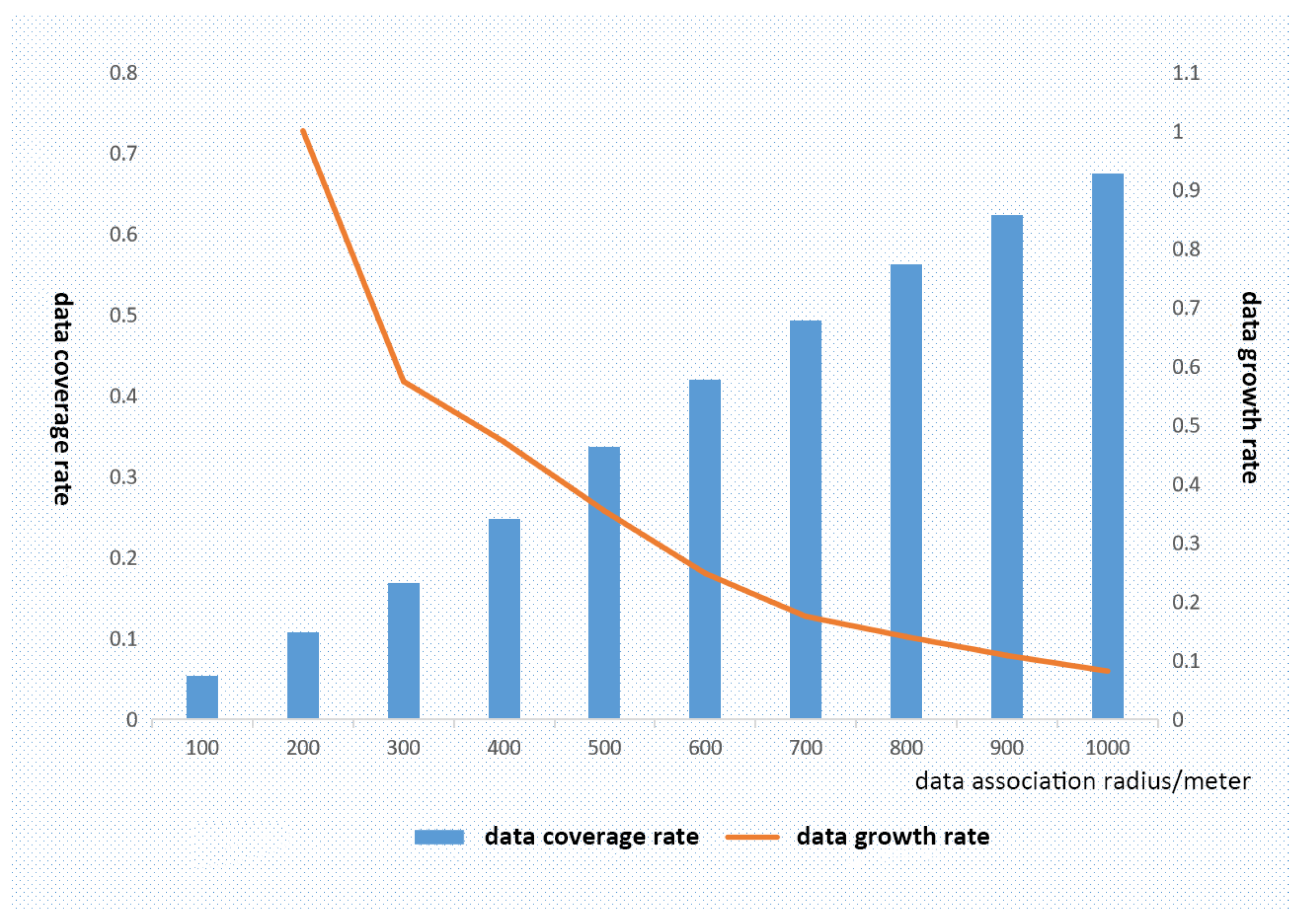
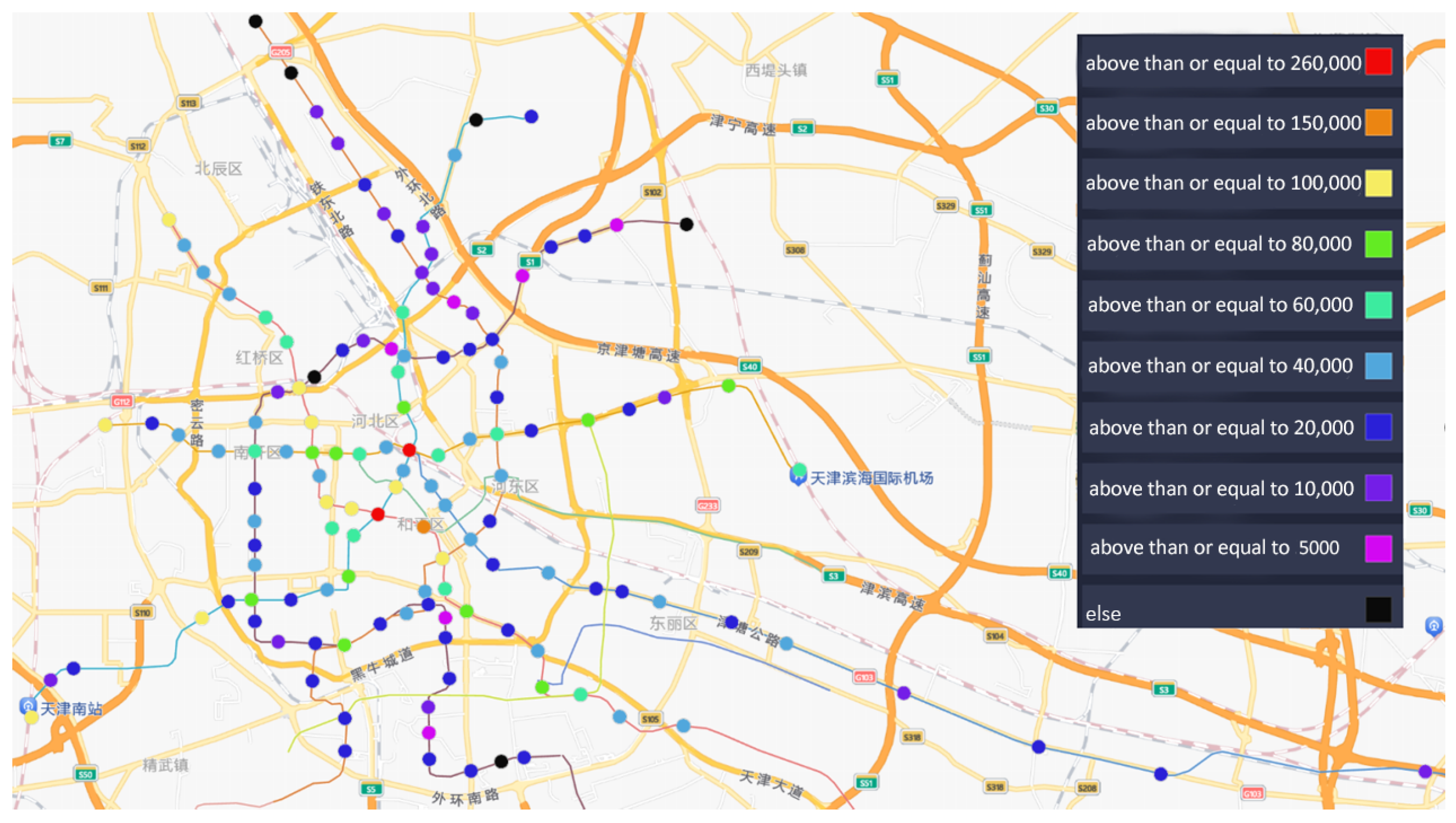
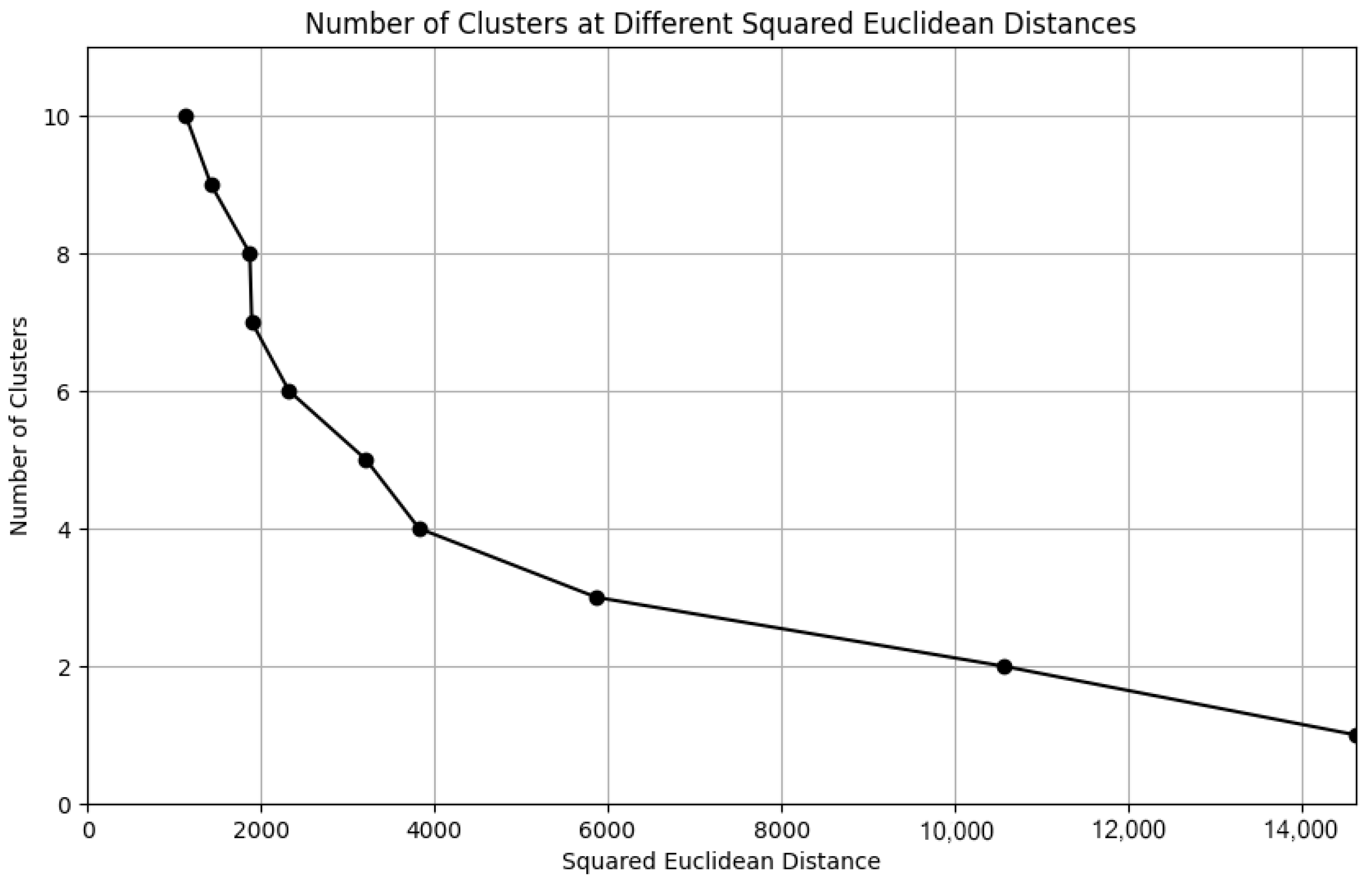

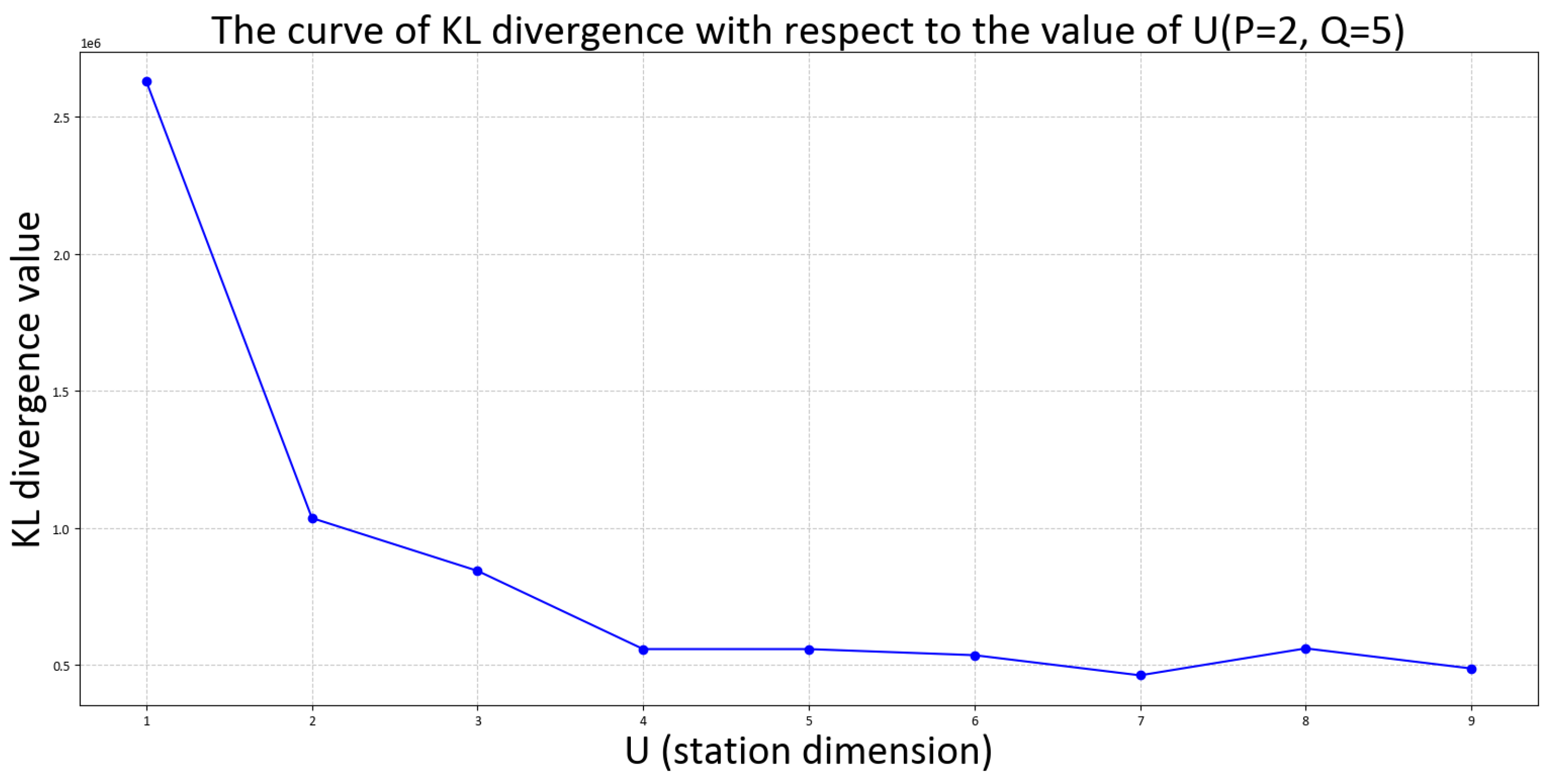
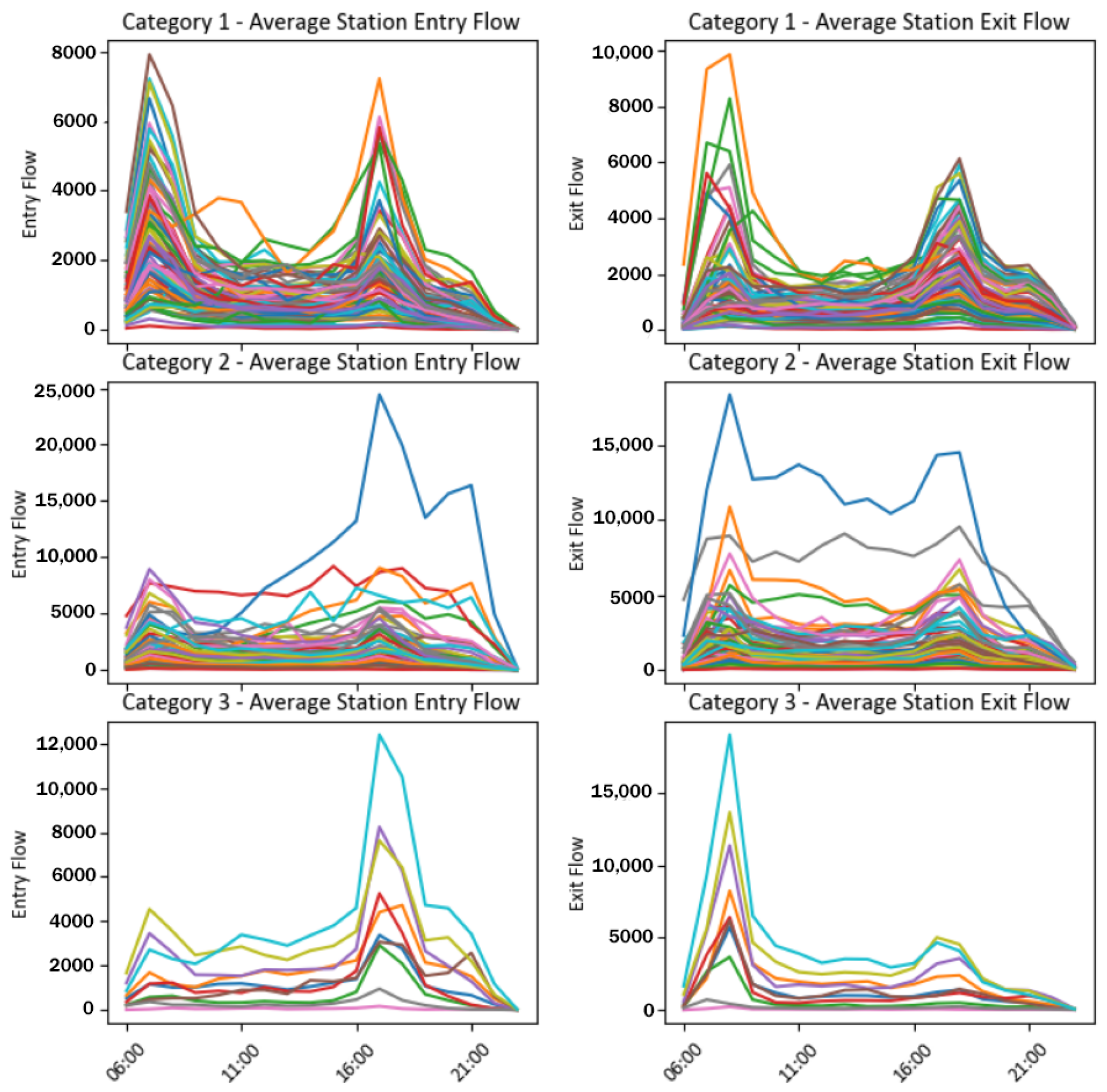
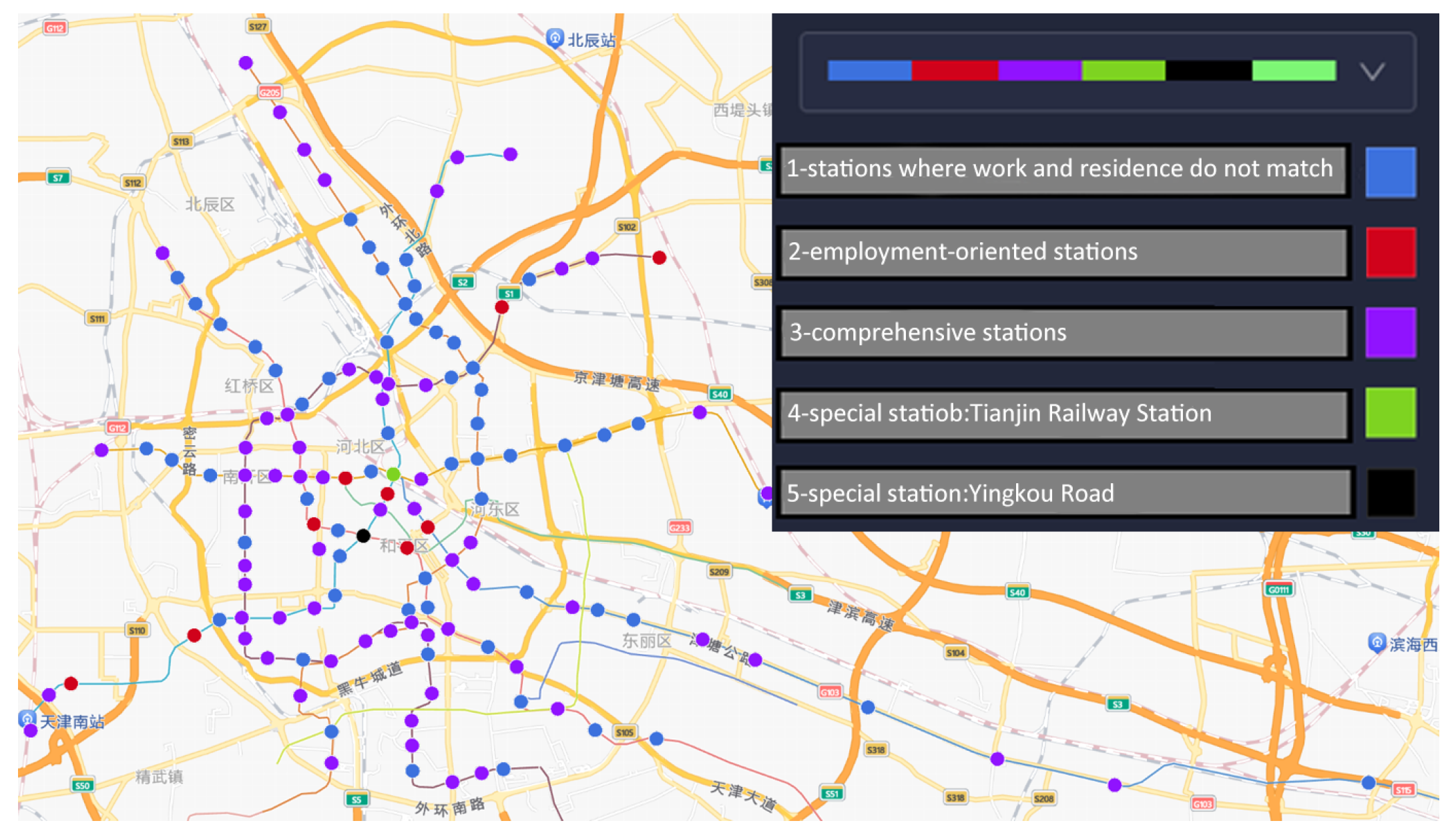
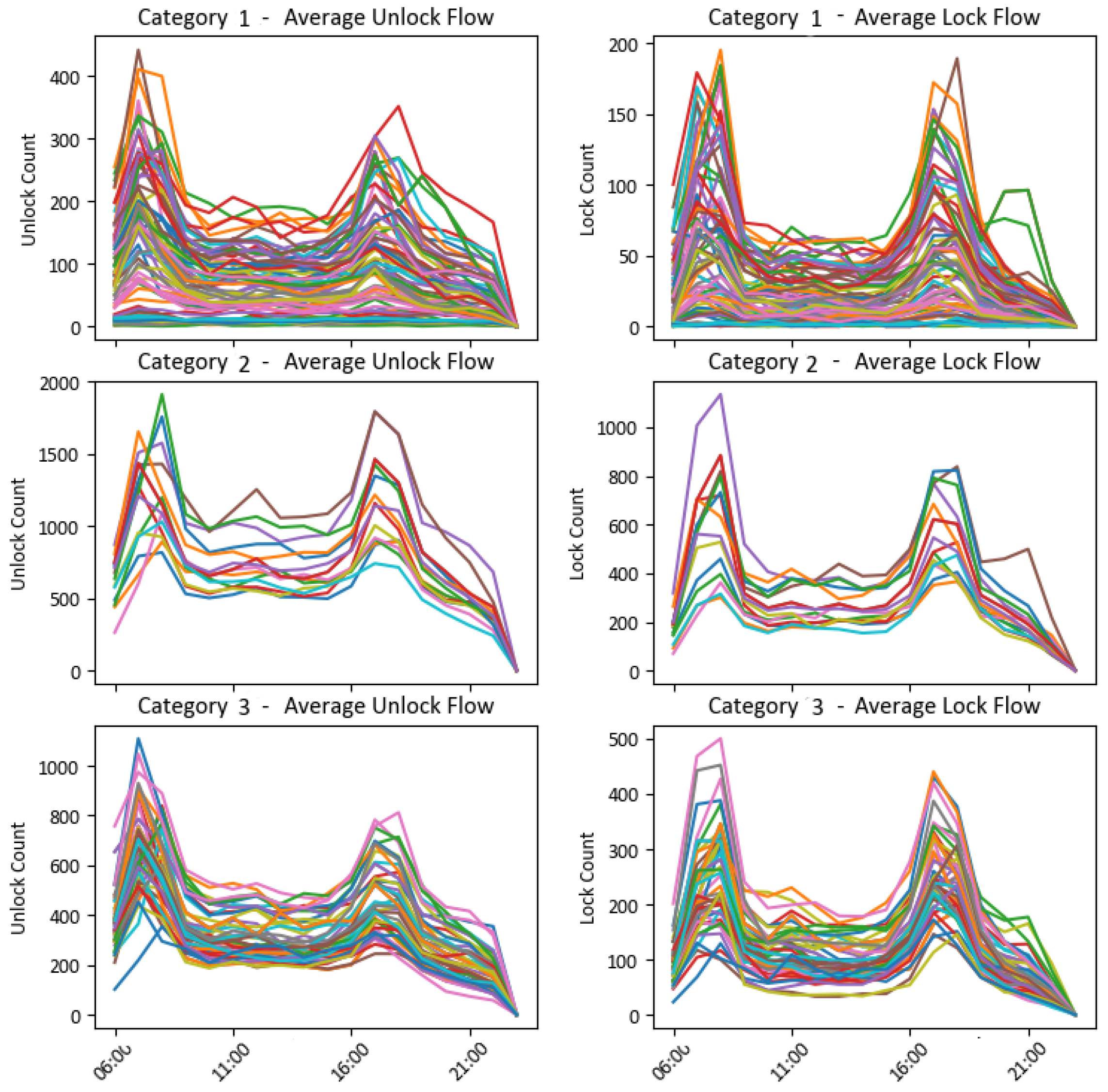
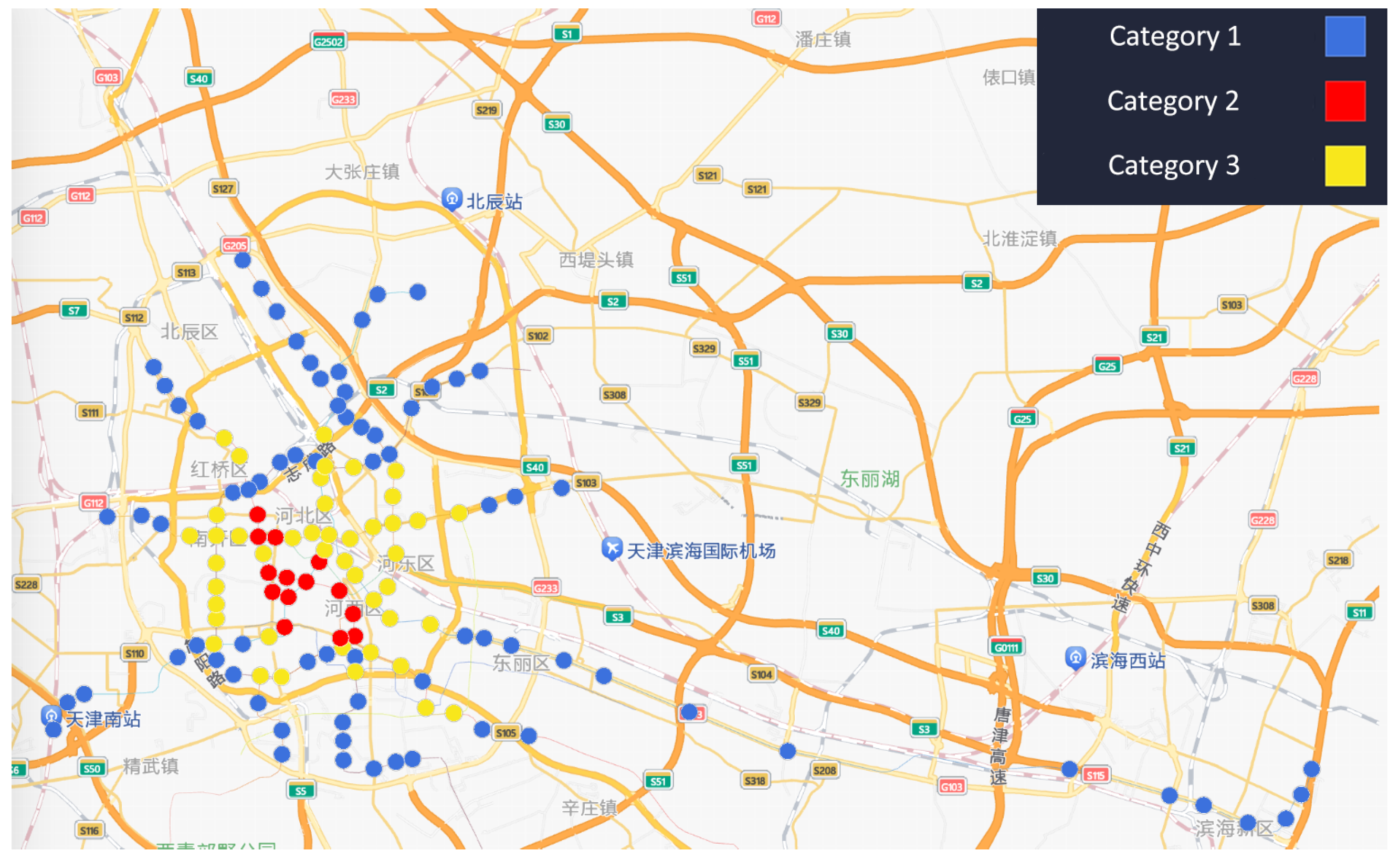
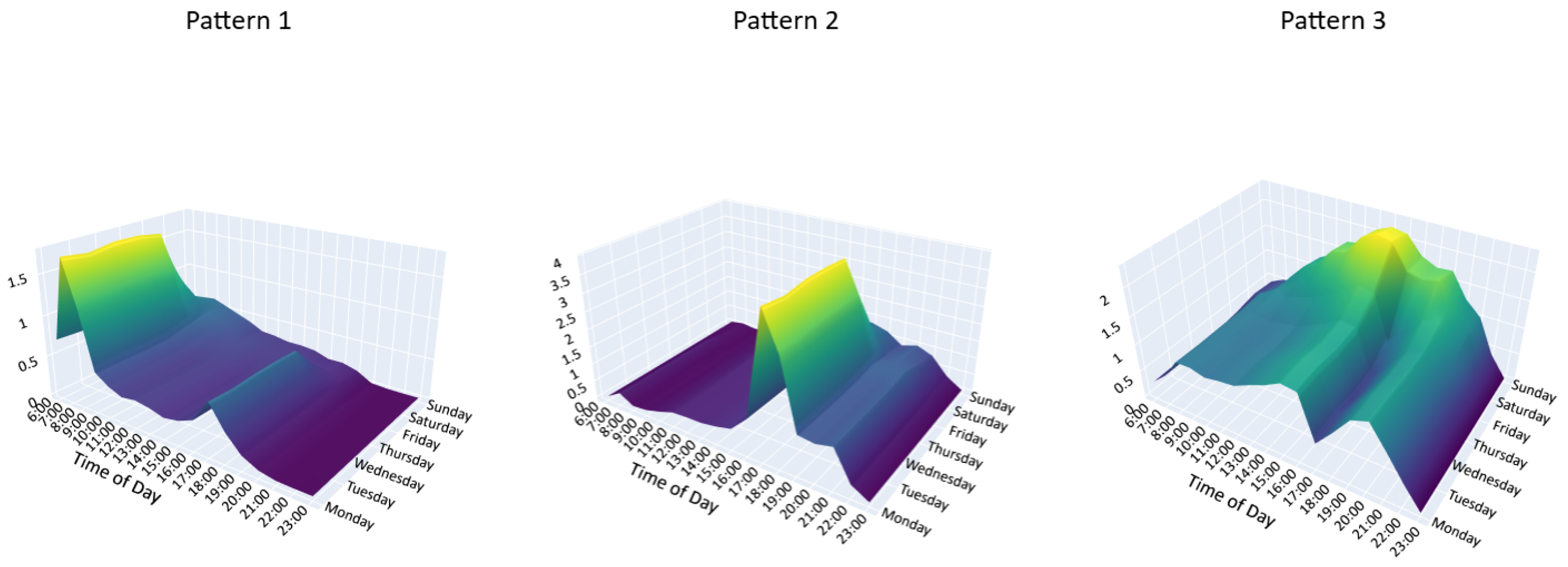
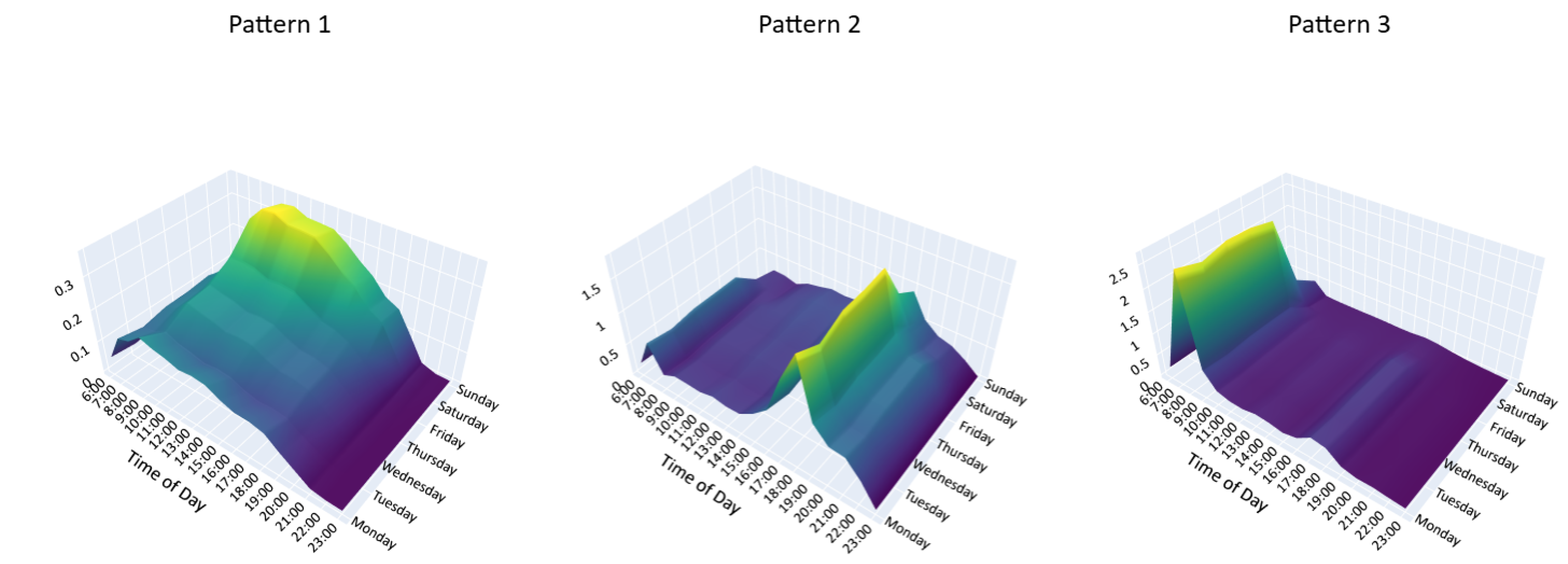
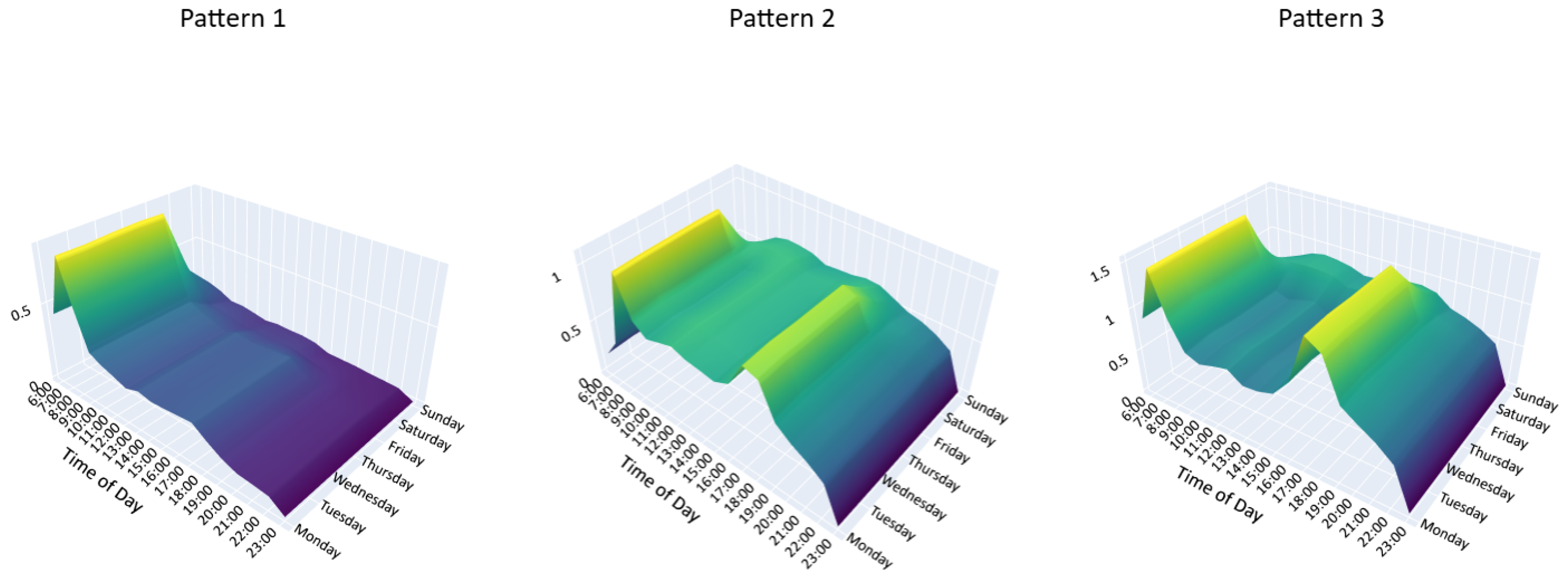
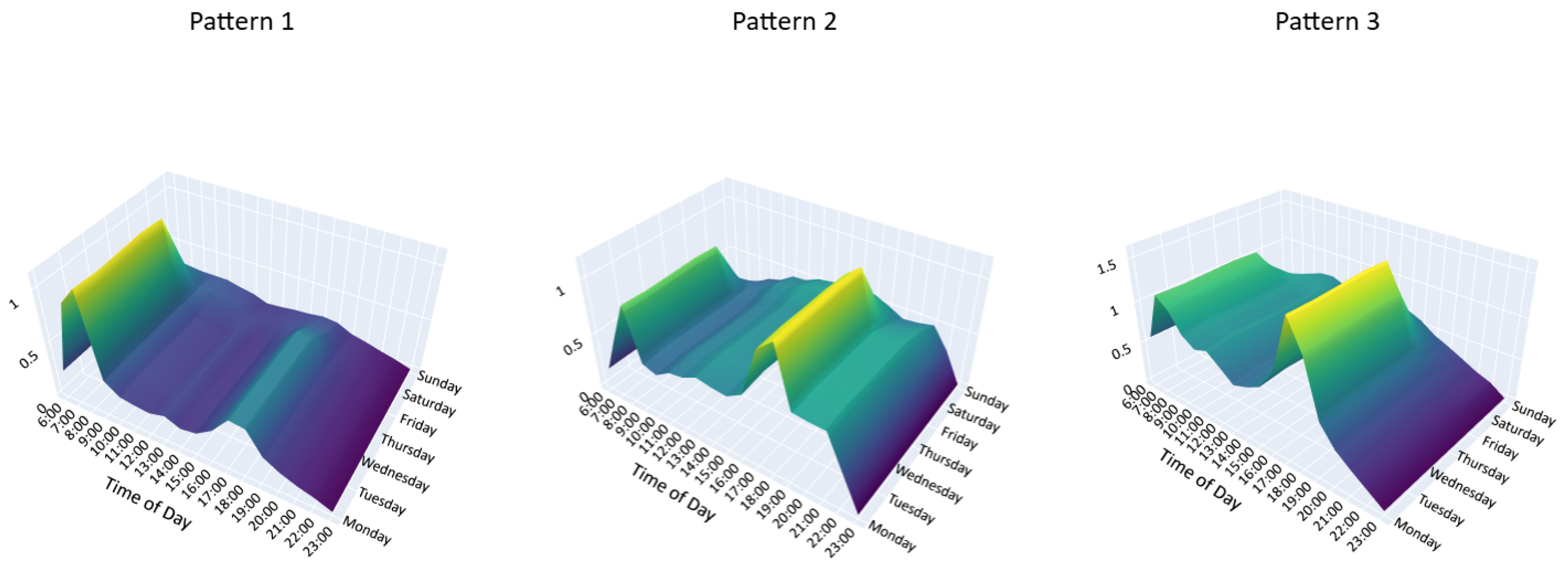
| Station ID | Station Name | Time | Metro Entries | Metro Exits | Bike Unlocks | Bike Locks |
|---|---|---|---|---|---|---|
| 257 | Xikang Road | 07:00 | 5032 | 6580 | 1417 | 1072 |
| 08:00 | 2985 | 8479 | 1554 | 1184 | ||
| 09:00 | 1566 | 2582 | 912 | 491 | ||
| 10:00 | 1551 | 1359 | 832 | 371 | ||
| 11:00 | 1563 | 1330 | 1003 | 367 |
| Category | Name | No. of Stations | Representative Station Names |
|---|---|---|---|
| 1 | Mismatched | 61 | Donghai Rd, Exhibition Center, Taihu Rd, Citizen Square, Shuishang Park, Zhangguizhuang, Zhongshanmen, Qiaobei Rd, Changzhou Rd, Sports Center, Jinwan Plaza, Tianjin Hotel, Baidi Rd, etc. |
| 2 | Employment-Oriented | 11 | Shiyi Ave, Yingshui West, Nankai Park, Finance & Economics Univ., Xiaowangzhuang, Xiaodian, etc. |
| 3 | Comprehensive | 67 | Haiguangsi, Xinanjiao, Dazhigu, Wudadao, Tianta, Shuishang East Rd, East/West Railway Station, Yujiapu, Meilin Rd, Financial Street, Tianjin Ave, etc. |
| Bike Pattern 1 | Bike Pattern 2 | Bike Pattern 3 | |
|---|---|---|---|
| Metro Pattern 1 | 0.52 | 0.14 | 0.30 |
| Metro Pattern 2 | 0.02 | 0.22 | 0.08 |
| Metro Pattern 3 | 0.04 | 0.03 | 0.01 |
| Bike Pattern 1 | Bike Pattern 2 | Bike Pattern 3 | |
|---|---|---|---|
| Metro Pattern 1 | 0.20 | 0.23 | 0.22 |
| Metro Pattern 2 | 0.49 | 0.02 | 0.17 |
| Metro Pattern 3 | 0.08 | 0.21 | 0.17 |
Disclaimer/Publisher’s Note: The statements, opinions and data contained in all publications are solely those of the individual author(s) and contributor(s) and not of MDPI and/or the editor(s). MDPI and/or the editor(s) disclaim responsibility for any injury to people or property resulting from any ideas, methods, instructions or products referred to in the content. |
© 2025 by the authors. Licensee MDPI, Basel, Switzerland. This article is an open access article distributed under the terms and conditions of the Creative Commons Attribution (CC BY) license (https://creativecommons.org/licenses/by/4.0/).
Share and Cite
Kang, X.; Jin, Z.; Ma, Y.; Cao, D.; Zhang, J. Mining Multimodal Travel Patterns of Metro and Bikesharing Using Tensor Decomposition and Clustering. Smart Cities 2025, 8, 151. https://doi.org/10.3390/smartcities8050151
Kang X, Jin Z, Ma Y, Cao D, Zhang J. Mining Multimodal Travel Patterns of Metro and Bikesharing Using Tensor Decomposition and Clustering. Smart Cities. 2025; 8(5):151. https://doi.org/10.3390/smartcities8050151
Chicago/Turabian StyleKang, Xi, Zhiyuan Jin, Yuxin Ma, Danni Cao, and Jian Zhang. 2025. "Mining Multimodal Travel Patterns of Metro and Bikesharing Using Tensor Decomposition and Clustering" Smart Cities 8, no. 5: 151. https://doi.org/10.3390/smartcities8050151
APA StyleKang, X., Jin, Z., Ma, Y., Cao, D., & Zhang, J. (2025). Mining Multimodal Travel Patterns of Metro and Bikesharing Using Tensor Decomposition and Clustering. Smart Cities, 8(5), 151. https://doi.org/10.3390/smartcities8050151








